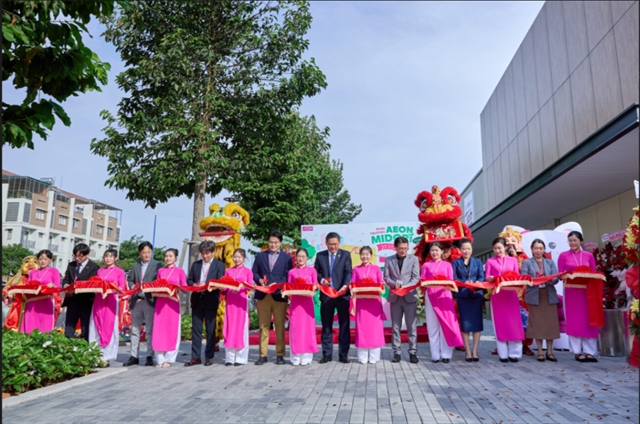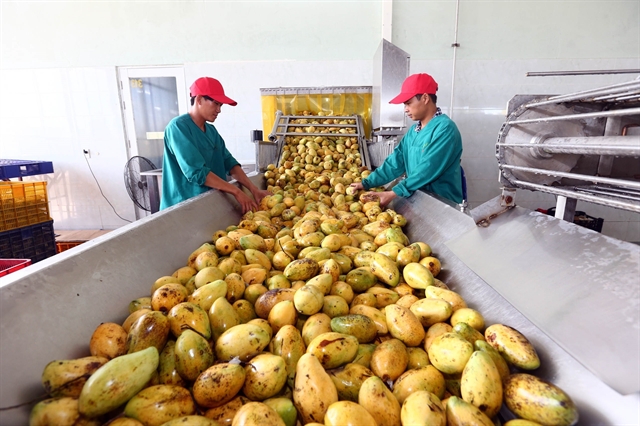 Economy
Economy


|
| An export processing line for fruit at the Nafoods company. VNA/VNS Photo |
HÀ NỘI — Agricultural exports are no longer a game of cheap prices or easy-going markets. As technical barriers become increasingly strict, proactive adaptation from growing areas to processing, logistics, is a vital condition for Vietnamese agricultural products to firmly stand on the global playing field.
Markets raise standards
According to the Việt Nam Fruits and Vegetables Association (Vinafruit), the export turnover of vegetables and fruits for last month is estimated at US$496 million.
The estimated export turnover of vegetables and fruits reached $2.1 billion in the first five months of this year, down 17.8 per cent year-on-year.
China is still the largest import market for vegetables and fruits of Việt Nam, but it is also the place that recorded the deepest decline.
The turnover to China reached $777 million in the first four months of the year, down 33 per cent.
The general secretary of Vinafruit, Đặng Phúc Nguyên, said that the decline in fruit and vegetable exports mainly came from the fact that durian exports had not met expectations.
The deputy director of the Việt Nam Sanitary and Phytosanitary Notification Authority and Enquiry Point (SPS Vietnam) Ngô Xuân Nam, under the Ministry of Agriculture and Environment, said that the Chinese market recently increased the frequency of inspections, raised standards for chemical residue levels and introduced new requirements, including additional labels, growing area codes and packaging facility codes.
Indonesia had also just notified the WTO about the integrated quarantine model, setting new standards for imported goods.
Japan, the EU and Arab countries also regularly changed regulations on pesticide residue levels.
The Đại Đoàn Kết (Great Unity) newspaper quoted Nam as saying that in the past, Vietnamese enterprises often prioritised exporting to markets that were considered more lenient, with fewer technical barriers.
However, in the trend of globalisation, countries, including ASEAN and the Middle East, had established and improved SPS measures, from pesticide residues to traceability.
“If enterprises do not proactively grasp and comply with international regulations, the risk of being eliminated from the supply chain is very high,” emphasised Nam.
At the same time, he mentioned that to assist enterprises in effective implementation, the SPS Vietnam had co-ordinated with the Digital Conversion Department and Information Resource Data, Ministry of Agriculture and Environment, to launch the National SPS Information Portal.
This portal would promptly update SPS measures of WTO members, guide the correct declarations and provide clear resources for each target group.
It would serve as a technical platform for enterprises, co-operatives and producers to stay informed about SPS requirements and proactively adapt to them.
Standardising and producing through professional supply chains
Việt Nam currently exports agricultural products and food to 200 countries and territories. Therefore, enterprises must proactively establish integrated chains and organise production to meet the SPS requirements for each market.
Logistics is considered the lifeblood of the economy, especially for a country like Việt Nam, which exports tens of billions of US dollars worth of agricultural products annually.
However, the current logistics centre system in Việt Nam has not yet met core requirements such as standardised cold storage, traceability capabilities and fast delivery speeds.
According to a representative of the Agency for Foreign Trade under the Ministry of Industry and Trade, Đặng Hồng Nhung, the country currently has 69 logistics centres, nearly a tenfold increase compared to the 2007-2012 period.
However, uneven distribution and a lack of regional connectivity have caused many logistics centres to operate separately, failing to take advantage of scale. Key production areas such as the Mekong Delta and the Central Highlands, which supply the majority of vegetables, fruits and seafood, still lack specialised storage and distribution facilities.
This reality has forced many export enterprises to divide their operations, hire temporary services or invest in individual cold storage facilities, leading to higher costs and longer delivery times.
"Việt Nam is a large agricultural country, but still lacks a logistics system that matches its scale. Without specialised centres, synchronous connections and technological integration, it will be difficult to maintain export growth in the coming years," said Nhung.
To secure a strong foothold in the markets, the agricultural sector and the fruit and vegetable sector in particular, would need a fundamental and comprehensive transformation with active involvement from both the public and private sectors, said Lê Quốc Thành, director of the National Agricultural Extension Centre.
This would require promoting production along the value chain, with the participation of businesses, cooperatives, farmers and management agencies, strengthening quality control from cultivation to packaging and processing, and implementing programmes to monitor chemical residues.
In other words, Vietnamese agricultural products and vegetables must be produced through a professional chain. — VNS




